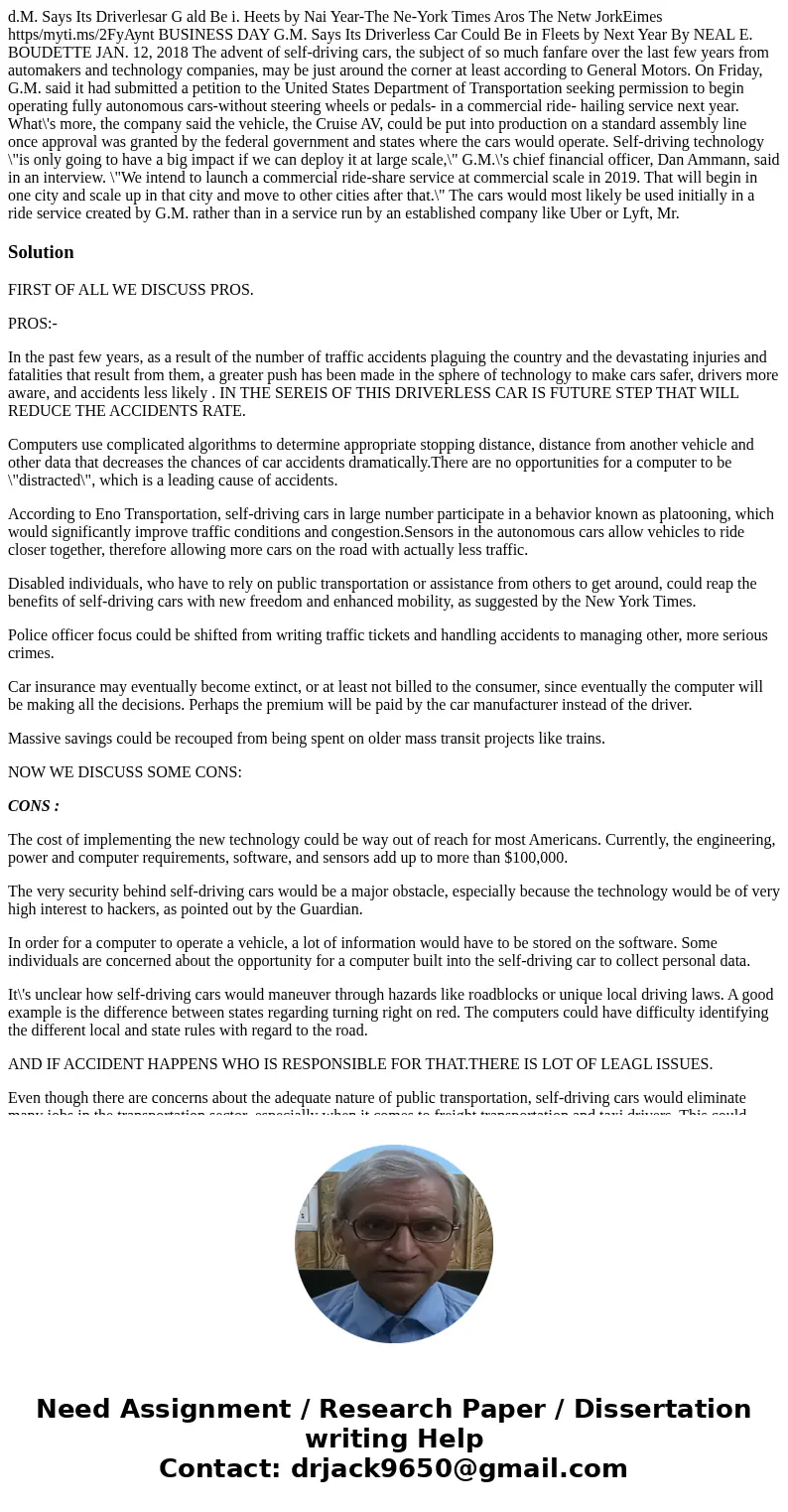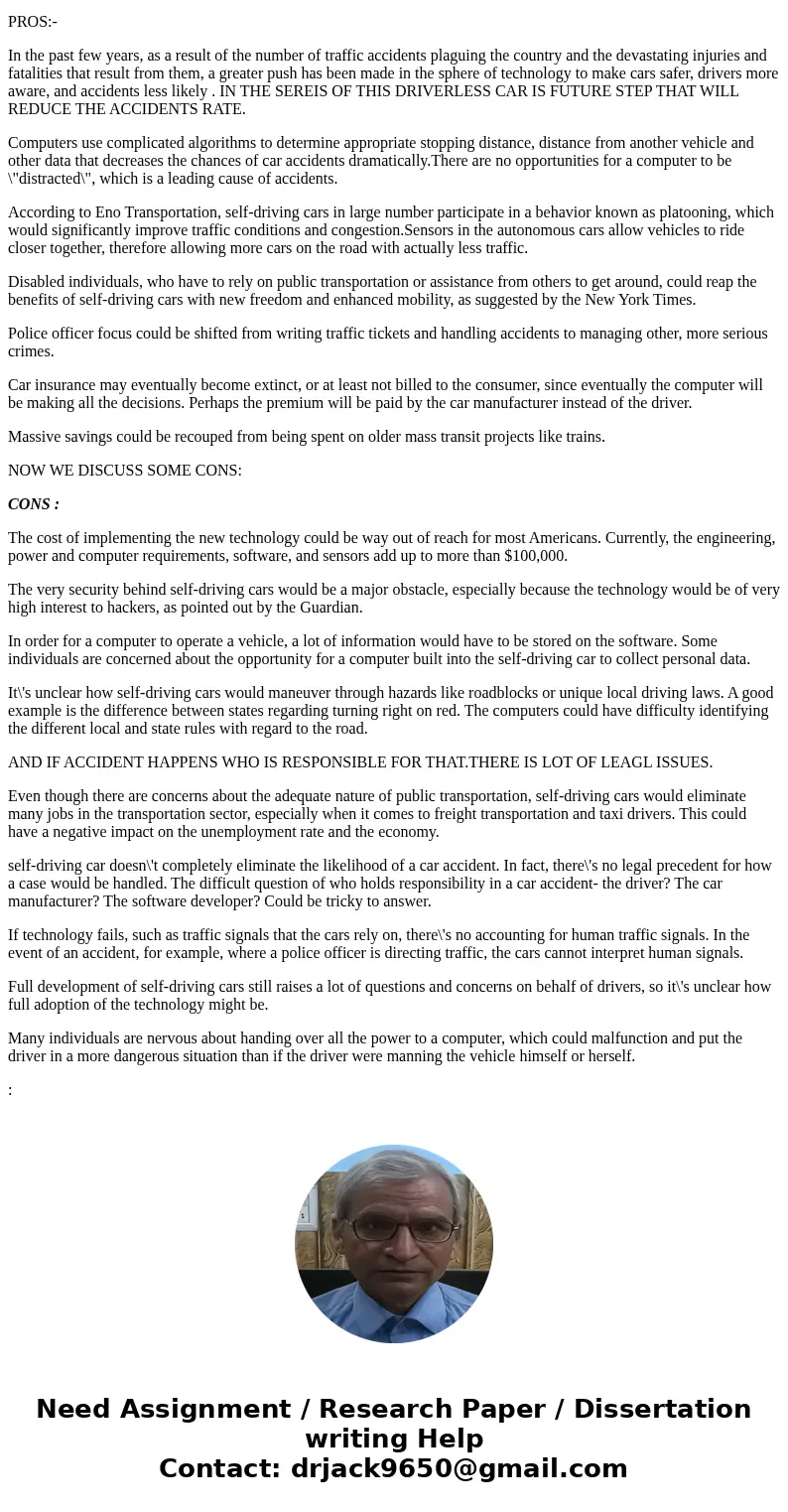dM Says Its Driverlesar G ald Be i Heets by Nai YearThe NeYo
Solution
FIRST OF ALL WE DISCUSS PROS.
PROS:-
In the past few years, as a result of the number of traffic accidents plaguing the country and the devastating injuries and fatalities that result from them, a greater push has been made in the sphere of technology to make cars safer, drivers more aware, and accidents less likely . IN THE SEREIS OF THIS DRIVERLESS CAR IS FUTURE STEP THAT WILL REDUCE THE ACCIDENTS RATE.
Computers use complicated algorithms to determine appropriate stopping distance, distance from another vehicle and other data that decreases the chances of car accidents dramatically.There are no opportunities for a computer to be \"distracted\", which is a leading cause of accidents.
According to Eno Transportation, self-driving cars in large number participate in a behavior known as platooning, which would significantly improve traffic conditions and congestion.Sensors in the autonomous cars allow vehicles to ride closer together, therefore allowing more cars on the road with actually less traffic.
Disabled individuals, who have to rely on public transportation or assistance from others to get around, could reap the benefits of self-driving cars with new freedom and enhanced mobility, as suggested by the New York Times.
Police officer focus could be shifted from writing traffic tickets and handling accidents to managing other, more serious crimes.
Car insurance may eventually become extinct, or at least not billed to the consumer, since eventually the computer will be making all the decisions. Perhaps the premium will be paid by the car manufacturer instead of the driver.
Massive savings could be recouped from being spent on older mass transit projects like trains.
NOW WE DISCUSS SOME CONS:
CONS :
The cost of implementing the new technology could be way out of reach for most Americans. Currently, the engineering, power and computer requirements, software, and sensors add up to more than $100,000.
The very security behind self-driving cars would be a major obstacle, especially because the technology would be of very high interest to hackers, as pointed out by the Guardian.
In order for a computer to operate a vehicle, a lot of information would have to be stored on the software. Some individuals are concerned about the opportunity for a computer built into the self-driving car to collect personal data.
It\'s unclear how self-driving cars would maneuver through hazards like roadblocks or unique local driving laws. A good example is the difference between states regarding turning right on red. The computers could have difficulty identifying the different local and state rules with regard to the road.
AND IF ACCIDENT HAPPENS WHO IS RESPONSIBLE FOR THAT.THERE IS LOT OF LEAGL ISSUES.
Even though there are concerns about the adequate nature of public transportation, self-driving cars would eliminate many jobs in the transportation sector, especially when it comes to freight transportation and taxi drivers. This could have a negative impact on the unemployment rate and the economy.
self-driving car doesn\'t completely eliminate the likelihood of a car accident. In fact, there\'s no legal precedent for how a case would be handled. The difficult question of who holds responsibility in a car accident- the driver? The car manufacturer? The software developer? Could be tricky to answer.
If technology fails, such as traffic signals that the cars rely on, there\'s no accounting for human traffic signals. In the event of an accident, for example, where a police officer is directing traffic, the cars cannot interpret human signals.
Full development of self-driving cars still raises a lot of questions and concerns on behalf of drivers, so it\'s unclear how full adoption of the technology might be.
Many individuals are nervous about handing over all the power to a computer, which could malfunction and put the driver in a more dangerous situation than if the driver were manning the vehicle himself or herself.
:


 Homework Sourse
Homework Sourse